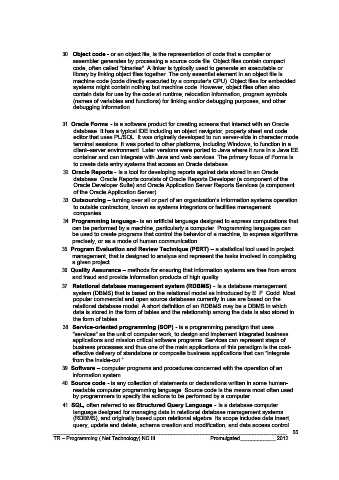Page 250 - aREA ix eXHIBITS
P. 250
30. Object code - or an object file, is the representation of code that a compiler or
assembler generates by processing a source code file. Object files contain compact
code, often called "binaries". A linker is typically used to generate an executable or
library by linking object files together. The only essential element in an object file is
machine code (code directly executed by a computer's CPU). Object files for embedded
systems might contain nothing but machine code. However, object files often also
contain data for use by the code at runtime, relocation information, program symbols
(names of variables and functions) for linking and/or debugging purposes, and other
debugging information.
31. Oracle Forms - is a software product for creating screens that interact with an Oracle
database. It has a typical IDE including an object navigator, property sheet and code
editor that uses PL/SQL. It was originally developed to run server-side in character mode
terminal sessions. It was ported to other platforms, including Windows, to function in a
client–server environment. Later versions were ported to Java where it runs in a Java EE
container and can integrate with Java and web services. The primary focus of Forms is
to create data entry systems that access an Oracle database.
32. Oracle Reports - is a tool for developing reports against data stored in an Oracle
database. Oracle Reports consists of Oracle Reports Developer (a component of the
Oracle Developer Suite) and Oracle Application Server Reports Services (a component
of the Oracle Application Server).
33. Outsourcing – turning over all or part of an organization’s information systems operation
to outside contractors, known as systems integrators or facilities management
companies.
34. Programming language - is an artificial language designed to express computations that
can be performed by a machine, particularly a computer. Programming languages can
be used to create programs that control the behavior of a machine, to express algorithms
precisely, or as a mode of human communication.
35. Program Evaluation and Review Technique (PERT) – a statistical tool used in project
management, that is designed to analyze and represent the tasks involved in completing
a given project.
36. Quality Assurance – methods for ensuring that information systems are free from errors
and fraud and provide information products of high quality.
37. Relational database management system (RDBMS) - is a database management
system (DBMS) that is based on the relational model as introduced by E. F. Codd. Most
popular commercial and open source databases currently in use are based on the
relational database model. A short definition of an RDBMS may be a DBMS in which
data is stored in the form of tables and the relationship among the data is also stored in
the form of tables.
38. Service-oriented programming (SOP) - is a programming paradigm that uses
"services" as the unit of computer work, to design and implement integrated business
applications and mission critical software programs. Services can represent steps of
business processes and thus one of the main applications of this paradigm is the cost-
effective delivery of standalone or composite business applications that can “integrate
from the inside-out.”
39. Software – computer programs and procedures concerned with the operation of an
information system.
40. Source code - is any collection of statements or declarations written in some human-
readable computer programming language. Source code is the means most often used
by programmers to specify the actions to be performed by a computer.
41. SQL, often referred to as Structured Query Language - is a database computer
language designed for managing data in relational database management systems
(RDBMS), and originally based upon relational algebra. Its scope includes data insert,
query, update and delete, schema creation and modification, and data access control.
_________________________________________________________________________________ 55
TR – Programming (.Net Technology) NC III Promulgated____________ 2013

